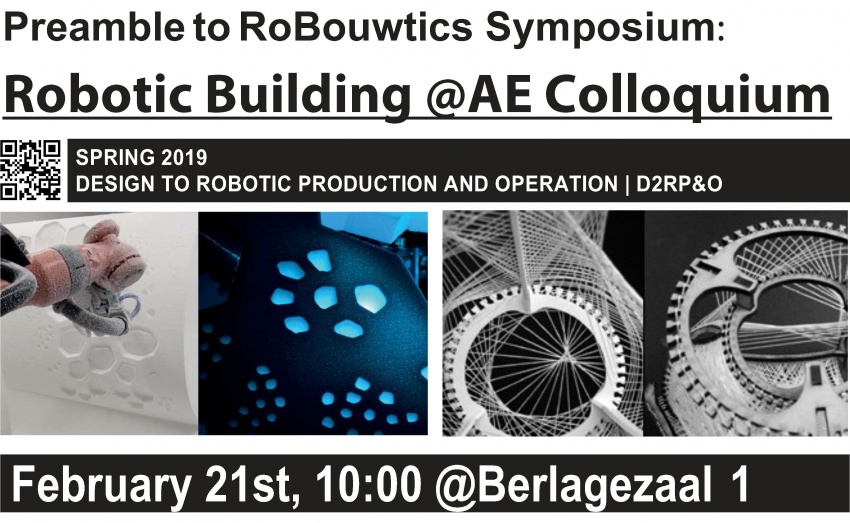Difference between revisions of "2019Lectures"
(→Speakers) |
|||
| Line 7: | Line 7: | ||
The RB colloquium with invited guest from academia and practice will address the use of computational design and robotic manufacturing to empower architects to regain control over the design implementation and also allow endusers to participate as co-creators in the design and in the adaptation/customisation of their environments over time. | The RB colloquium with invited guest from academia and practice will address the use of computational design and robotic manufacturing to empower architects to regain control over the design implementation and also allow endusers to participate as co-creators in the design and in the adaptation/customisation of their environments over time. | ||
| − | '''10:00-10:15''' Thijs Asselbergs: | + | '''10:00-10:15''' Thijs Asselbergs: Intro |
'''10:15-10:45''' Henriette Bier & Arwin Hidding, TUD: Design-to-Robotic- | '''10:15-10:45''' Henriette Bier & Arwin Hidding, TUD: Design-to-Robotic- | ||
Production-Assembly and –Operation | Production-Assembly and –Operation | ||
| − | '''10:45-11:15''' | + | '''10:45-11:15''' Roland Schmehl, TUD: KitePower for Autarkic Systems of Production and Operation |
| − | '''11 | + | '''11:15-11:45''' Jelle Feringa, Aectual: Are robotics challenging the Corbusian maxim |
| − | + | ||
| − | + | ||
“architecture is not building”? | “architecture is not building”? | ||
| − | ''' | + | '''11:45-11:00''' Henriette Bier: Q&A / Concluding remarks |
===Speakers=== | ===Speakers=== | ||
<br> | <br> | ||
| − | ''' | + | '''Roland Schmehl''' graduated in 1994 from Karlsruhe University, Germany, in Mechanical Engineering. Following his PhD research on computational modelling of multiphase flows and liquid droplet dynamics he worked for the European Space Agency and TNO Automotive Safety Solutions before accepting a position as Associate Professor at the Faculty of Aerospace Engineering of Delft University of Technology. His research focus is Airborne Wind Energy and he coordinates two major EU Horizon 2020 projects on the subject. |
| − | + | ||
| − | + | ||
<br><br> | <br><br> | ||
'''Jelle Feringa''' is CTO of Aectual where he oversees robotic and software engineering, and tends to material and product development. He is co-founder of Odico formwork robotics, the first publicly traded architectural robotics company. He has taught and lectured at the Bartlett, Architectural Association, Paris-Malaquias, ETH Zürich, TU Delft and Aarhus School of Architecture and is an active contributor to open source software. With Thomas Paviot, he has been driving the development of an open source CAD framework, PythonOCC.. He is a founding partner in EZCT Architecture & Design Research. The work of the office is widely exhibited, exhibitions include the Mori Art Museum, Tokyo, Archilab, Orléans, Barbican Gallery Design Miami/Basel. Projects by the office are part of Pompidou Center permanent collection. The work of the office was recently displayed at Imprimer and Compter le Monde. | '''Jelle Feringa''' is CTO of Aectual where he oversees robotic and software engineering, and tends to material and product development. He is co-founder of Odico formwork robotics, the first publicly traded architectural robotics company. He has taught and lectured at the Bartlett, Architectural Association, Paris-Malaquias, ETH Zürich, TU Delft and Aarhus School of Architecture and is an active contributor to open source software. With Thomas Paviot, he has been driving the development of an open source CAD framework, PythonOCC.. He is a founding partner in EZCT Architecture & Design Research. The work of the office is widely exhibited, exhibitions include the Mori Art Museum, Tokyo, Archilab, Orléans, Barbican Gallery Design Miami/Basel. Projects by the office are part of Pompidou Center permanent collection. The work of the office was recently displayed at Imprimer and Compter le Monde. | ||
Revision as of 15:17, 22 February 2019
February 21st, 10:00 @Berlagezaal 1, Robotic Building @AE Colloquium
The RB colloquium with invited guest from academia and practice will address the use of computational design and robotic manufacturing to empower architects to regain control over the design implementation and also allow endusers to participate as co-creators in the design and in the adaptation/customisation of their environments over time.
10:00-10:15 Thijs Asselbergs: Intro
10:15-10:45 Henriette Bier & Arwin Hidding, TUD: Design-to-Robotic- Production-Assembly and –Operation
10:45-11:15 Roland Schmehl, TUD: KitePower for Autarkic Systems of Production and Operation
11:15-11:45 Jelle Feringa, Aectual: Are robotics challenging the Corbusian maxim “architecture is not building”?
11:45-11:00 Henriette Bier: Q&A / Concluding remarks
Speakers
Roland Schmehl graduated in 1994 from Karlsruhe University, Germany, in Mechanical Engineering. Following his PhD research on computational modelling of multiphase flows and liquid droplet dynamics he worked for the European Space Agency and TNO Automotive Safety Solutions before accepting a position as Associate Professor at the Faculty of Aerospace Engineering of Delft University of Technology. His research focus is Airborne Wind Energy and he coordinates two major EU Horizon 2020 projects on the subject.
Jelle Feringa is CTO of Aectual where he oversees robotic and software engineering, and tends to material and product development. He is co-founder of Odico formwork robotics, the first publicly traded architectural robotics company. He has taught and lectured at the Bartlett, Architectural Association, Paris-Malaquias, ETH Zürich, TU Delft and Aarhus School of Architecture and is an active contributor to open source software. With Thomas Paviot, he has been driving the development of an open source CAD framework, PythonOCC.. He is a founding partner in EZCT Architecture & Design Research. The work of the office is widely exhibited, exhibitions include the Mori Art Museum, Tokyo, Archilab, Orléans, Barbican Gallery Design Miami/Basel. Projects by the office are part of Pompidou Center permanent collection. The work of the office was recently displayed at Imprimer and Compter le Monde.
